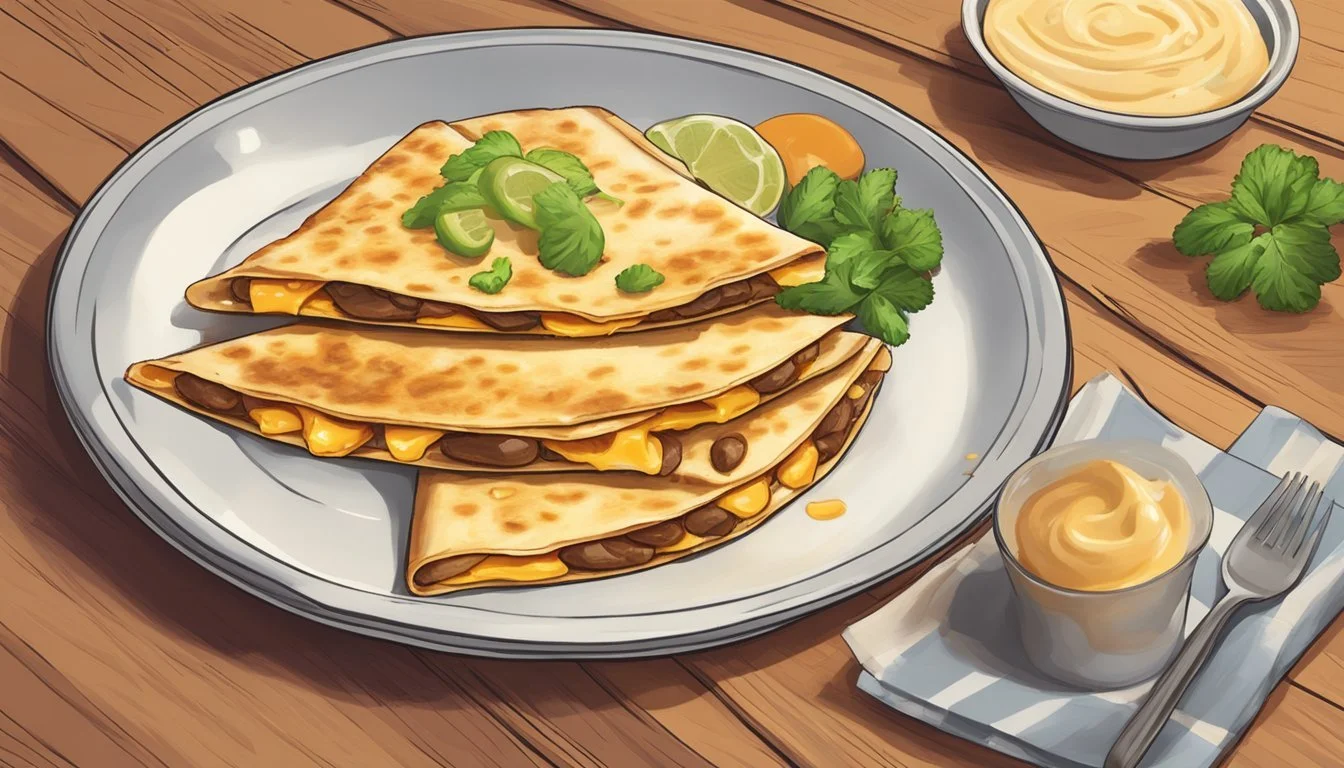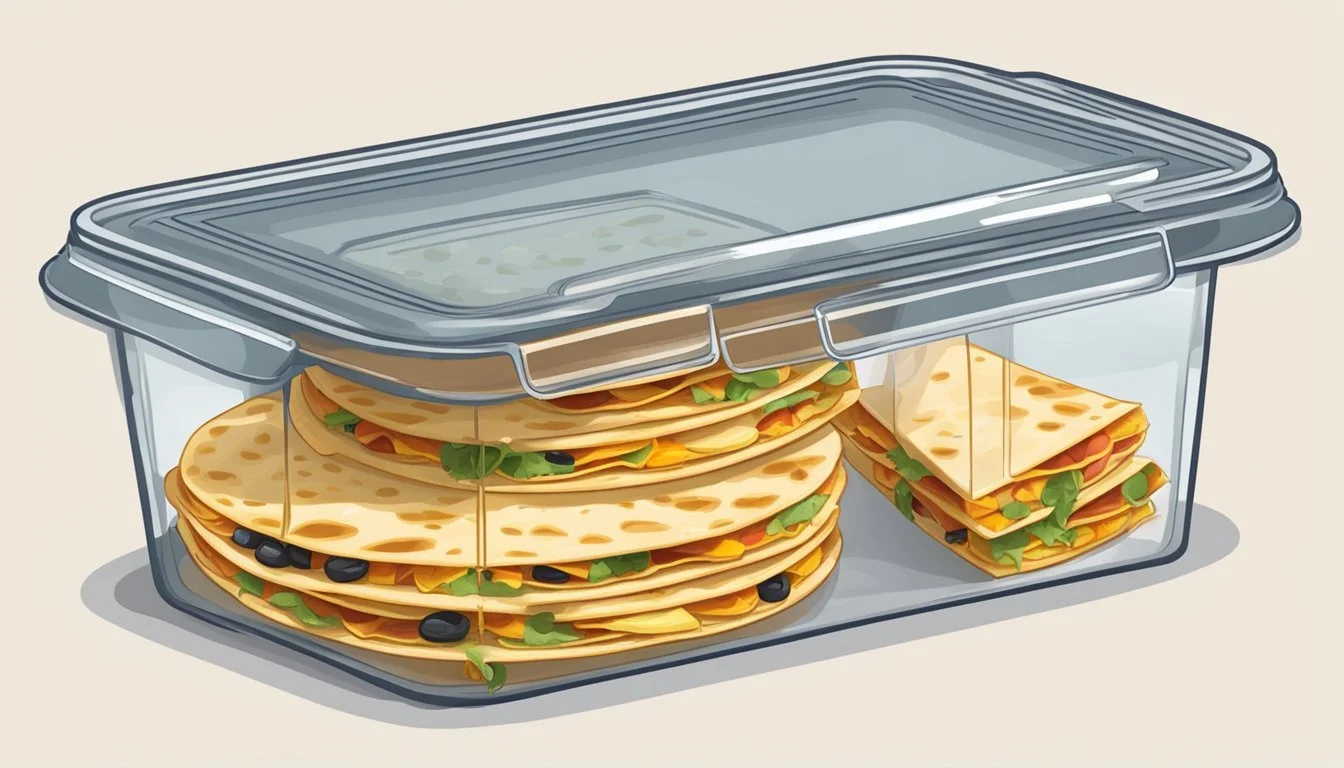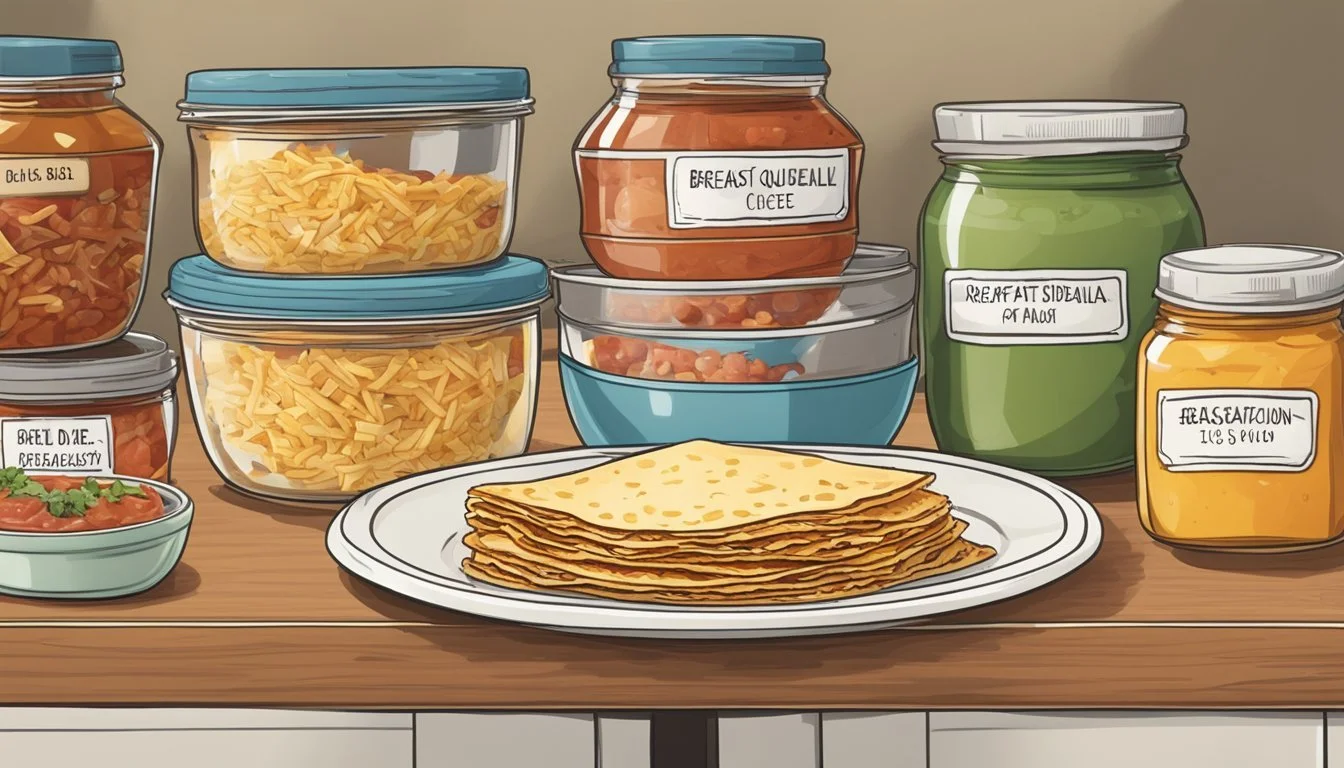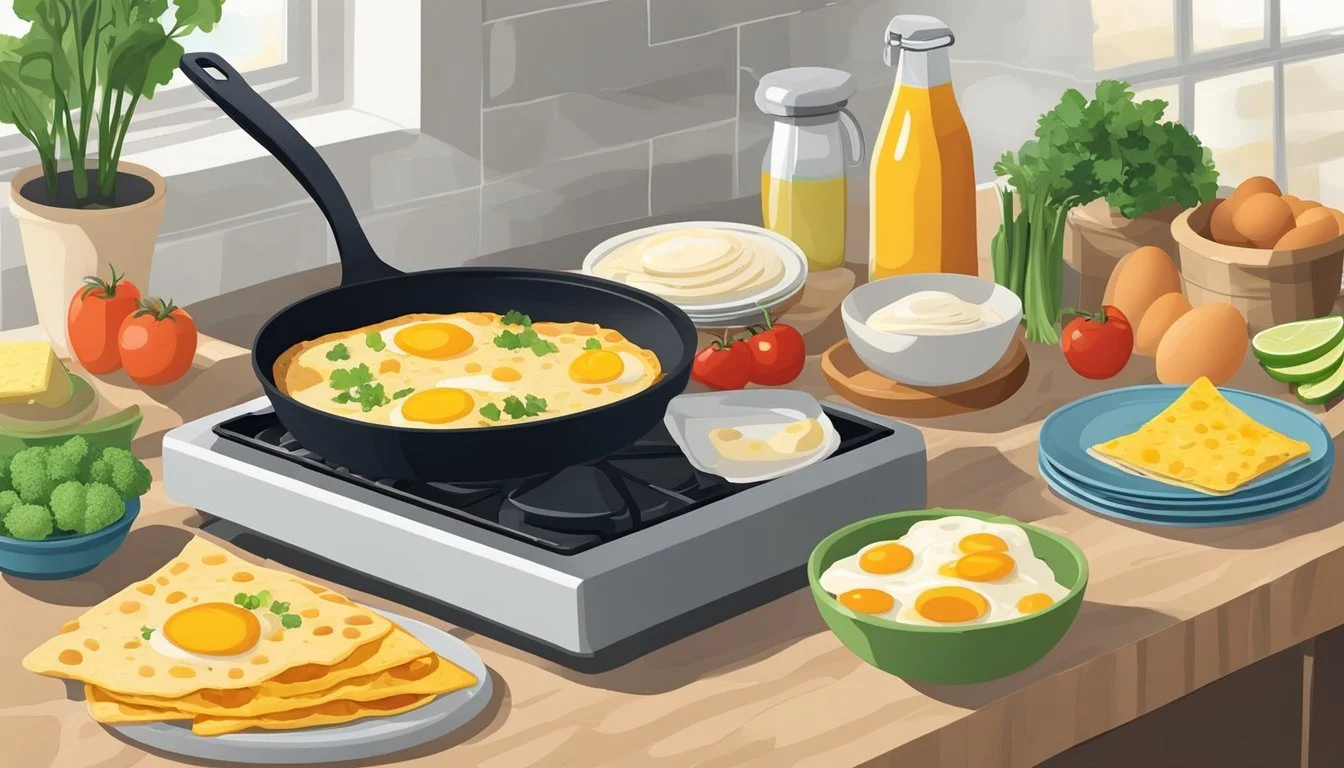How Long Do Breakfast Quesadillas Last?
A Guide to Shelf Life and Storage
Breakfast quesadillas are a delicious and versatile option for the most important meal of the day. Whether made with eggs, cheese, and your choice of meats or veggies, these savory treats can be prepared in advance, making them a convenient choice for busy mornings.
Breakfast quesadillas can last up to 3 days when stored properly in the refrigerator. To ensure they stay fresh, wrap them tightly in plastic wrap or place them in an airtight container. For longer storage, quesadillas can be frozen and enjoyed for up to 2 months.
Knowing how long breakfast quesadillas last can help reduce food waste and save time. The ability to store and quickly reheat them makes this dish not only delicious but practical for meal prepping.
Understanding Breakfast Quesadillas
Breakfast quesadillas are a versatile and delicious morning meal that combine tortillas with a variety of tasty fillings. They feature common ingredients such as eggs, cheese, and sometimes bacon, making them not only flavorful but also nutritious.
Key Ingredients
Tortillas: The foundation of a breakfast quesadilla is a soft, pliable tortilla. Flour tortillas are commonly used, though corn tortillas can also be an excellent choice for added texture and flavor.
Eggs: Scrambled or seasoned eggs make the quesadilla filling rich and satisfying. Whisking eggs with a splash of milk can make them extra fluffy.
Cheese: A generous layer of cheese, such as cheddar, mozzarella, or Monterey Jack, is essential. It melts beautifully and binds the ingredients together.
Bacon: Crispy bacon adds a savory, smoky flavor. Alternatively, ham or cooked sausage can be used. For a vegetarian option, sautéed spinach or bell peppers are great substitutes.
Oil: Cooking oil helps achieve a crispy exterior on the tortilla while ensuring the fillings are nice and hot.
Health and Nutrition
Eggs and Cheese: Eggs are an excellent source of protein and contain essential nutrients such as Vitamin A and choline. Cheese provides calcium and protein, contributing to bone health and satiety.
Vegetarian Options: Those who prefer a vegetarian quesadilla can include fibrous vegetables like spinach and bell peppers. Spinach is rich in Vitamin A and iron, making it a nutritious addition.
Bacon: While bacon offers flavor and protein, it also contains saturated fats and should be consumed in moderation. Opting for leaner meats or more vegetables can make this meal healthier.
Fiber: Using whole wheat tortillas can increase the fiber content of the quesadilla, aiding in digestion and providing sustained energy throughout the morning.
Proper Storage of Breakfast Quesadillas
Proper storage of breakfast quesadillas ensures they remain fresh, safe to eat, and maintain their cheesy goodness. It is essential to use correct methods to avoid spoilage and freezer burn.
Refrigerating Quesadillas
Breakfast quesadillas can be stored in the refrigerator for up to 3-4 days. To keep them fresh, place the quesadillas in an airtight container or wrap them tightly with plastic wrap or aluminum foil. This minimizes exposure to air, which can lead to dryness and spoilage.
When ready to reheat, using an air fryer can help retain crispiness. Preheat the air fryer to 350°F and heat the quesadillas for about 3-5 minutes. Alternatively, they can be reheated in a skillet over medium heat until warmed through. Avoid microwaving, as it can make the quesadillas soggy.
Freezing Quesadillas
For longer storage, breakfast quesadillas can be frozen for up to 2 months. Arrange the quesadillas in a single layer on a baking sheet and freeze until firm. Once frozen, transfer them to a freezer bag or an airtight container to prevent freezer burn.
To cook from frozen, remove the plastic wrap and place the quesadilla in the microwave. Warm it for 2-3 minutes until heated through. Reheating in an oven at 350°F for about 10-15 minutes can achieve a better texture. This method helps retain the original cheesy flavor and prevents sogginess.
Shelf Life Factors
The longevity of breakfast quesadillas depends on the ingredients used and their storage conditions. Both the freshness and type of ingredients, such as eggs, cheese, bacon, vegetables, and salsa, significantly influence how long the quesadillas remain safe to eat.
Ingredient Impact on Shelf Life
Eggs and dairy products like cheese and shredded cheese affect the shelf life. Eggs can spoil faster than other ingredients and require refrigeration. Cheese, especially when melted, can harbor bacteria if not stored correctly. Bacon is another ingredient that can shorten shelf life due to its high fat content, which can become rancid.
Vegetables may release moisture, causing the tortillas to become soggy and promoting bacterial growth. Salsa contains acidic elements that can help preserve the quesadilla to some extent but should still be refrigerated promptly.
Proper storage in airtight containers can extend freshness. In a refrigerator set below 40°F (4°C), quesadillas can last 3-4 days. Freezing is another option, with the quesadillas maintaining quality for 1-2 months.
Signs of Spoilage
Identifying spoilage in breakfast quesadillas is crucial for food safety. Unpleasant odor is a primary indicator; spoiled quesadillas will develop a sour or rancid smell. Texture changes like sogginess, especially near vegetables or salsa, can signal spoilage.
Visible mold growth on tortillas or cheese means the quesadilla is unfit for consumption. Discoloration of any ingredient, particularly eggs or bacon, is another sign. Consuming quesadillas with these spoilage indicators can lead to foodborne illnesses, so they should be discarded immediately.
Preparation Tips for Longevity
To ensure breakfast quesadillas have maximum freshness and taste, it is crucial to assemble and cook them properly. Follow these steps to create quesadillas that last longer and maintain their quality.
Assembling Tips
When assembling the quesadillas, start with fresh ingredients. Use a variety of fillings like cheese, scrambled eggs, and veggies.
Whisk eggs thoroughly to ensure a consistent texture and mix in any desired seasonings. Avoid overstuffing the quesadillas to make sure they close properly and prevent fillings from spilling out during cooking.
Lay each quesadilla flat and place fillings evenly, leaving a small border around the edge. A single layer of each filling ensures even cooking and prevents sogginess.
If preparing multiple quesadillas, stack them with parchment or wax paper in between to avoid sticking, making it easier to store them for later use.
Cooking Techniques
Cooking the quesadillas in one pan ensures uniform heat distribution. Preheat the pan over medium-high heat and avoid adding extra oil or cooking spray, which can make the quesadilla greasy.
To achieve a golden exterior and crispy texture, cook each quesadilla for about 2-3 minutes per side. Press down gently with a spatula to ensure even contact with the pan.
For best results, use moderate heat. Too high a temperature can burn the outside while leaving the inside undercooked. Instead, aim for a balanced, medium-high setting.
Consider finishing in an oven if preparing a large batch. This helps maintain a consistent internal temperature and further crisps up the exterior.
Safe Reheating Practices
When it comes to safely reheating breakfast quesadillas, the method chosen can impact both taste and texture. The proper techniques ensure your quesadillas remain delicious and safe to eat.
Reheating in a Skillet
Reheating breakfast quesadillas in a skillet is one of the most effective methods. Use a large skillet and set the heat to medium. Adding a small amount of extra-virgin olive oil helps achieve a crispy texture.
It's important to allow the skillet to heat thoroughly before placing the quesadilla in it. Heat each side for about one minute, ensuring the quesadilla is warmed through and the cheese melts evenly.
If you prefer a softer texture, cover the skillet with a lid while reheating. This traps some steam and helps heat the inside without over-crisping the exterior.
Reheating in an Air Fryer
An air fryer is another excellent option for reheating breakfast quesadillas. Preheat the air fryer to 350°F (175°C). Lay the quesadilla flat in the basket without stacking to ensure even heating.
Heat for about 3-4 minutes, checking intermittently to make sure the quesadilla doesn’t overcook. The result should be a quesadilla that is hot in the middle and crispy on the outside.
Spraying a light coat of cooking oil on both sides before reheating can enhance the quesadilla's crispness. This method is particularly useful for maintaining the dish's texture.
Serving Suggestions
When serving breakfast quesadillas, consider enhancing their flavor with suitable accompaniments and presenting them attractively to elevate the dining experience.
Accompaniments
Pair breakfast quesadillas with salsa or pico de gallo for a fresh, tangy complement. Avocado salsa or guacamole adds a creamy texture and rich taste, balancing the savoriness of the quesadilla.
For added richness, a dollop of sour cream can be a perfect touch. Fresh cilantro sprinkled on top not only adds a burst of color but also a fresh, citrusy note. These accompaniments can transform a simple quesadilla into a complete brunch dish.
Presentation
To make a visually appealing dish, slice the quesadilla into wedges and arrange them neatly on a plate. Surround the wedges with small bowls of salsa, guacamole, and sour cream for easy access. Garnish the plate with lime wedges and a sprinkle of fresh cilantro.
Using vibrant, contrasting colors from the accompaniments not only enhances the flavor but also the visual appeal. This approach makes the breakfast quesadillas inviting and suitable for any brunch setting.
Making Breakfast Quesadillas Unique
Breakfast quesadillas can be a blank canvas for culinary creativity. By experimenting with various ingredients and techniques, you can transform a simple meal into a distinctive, flavorful experience.
Creative Variations
Adding different cheeses can drastically change the flavor profile of breakfast quesadillas. Cheddar cheese offers a sharp taste, while mozzarella provides a milder, creamier texture. Mexican cheese blends combine multiple cheeses for a rich, complex flavor, and feta introduces a tangy, salty element.
For those seeking a healthy or vegetarian option, incorporate vegetables like spinach, bell peppers, and mushrooms. Protein-packed variations can include meats such as bacon, sausage, or smoked salmon. Beans or tofu can be used for vegetarian protein sources.
Making Quesadillas Special
One way to make quesadillas special is by selecting unique ingredients and combinations. For example, a vegetarian breakfast quesadilla with black beans, corn, and avocado provides a delicious and nutritious option. Use whole grain tortillas for a healthier twist.
Consider unique cooking methods such as using an air fryer to achieve a crispy quesadilla with less oil. Preparing make-ahead and freezer-friendly quesadillas can save time while preserving quality.
Customizing sauces and salsas, like a smoky chipotle sauce or a refreshing avocado salsa, can elevate the taste. Combining traditional components with unusual ingredients can create memorable and distinctive breakfast quesadillas.
Conclusion
Breakfast quesadillas offer a flexible and convenient meal option, suitable for various storage methods. When refrigerated, they can last up to four days if stored in an airtight container lined with a paper towel.
To extend their shelf life, freeze them.
Place the quesadillas in plastic wrap and tin foil, then into a freezer-safe bag.
Freezer Storage:
Maximum duration: 2-3 months
Freeze in a single layer first to avoid sticking.
Reheat directly from the freezer by microwaving or baking in the oven.
Proper storage methods ensure breakfast quesadillas remain a delicious, quick meal option at any time.










